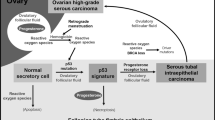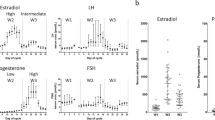Abstract
Although cancer of the cervix is traditionally considered not to be responsive to steroid hormones, an in vitro study has reported that the addition of oestrogen increased cellular proliferation in a cervix cancer cell line that was inhibited by progesterone. We investigated whether the reported in vitro effects of oestrogen and progesterone on cellular proliferation can be replicated in locally advanced cervical cancer in vivo and whether these effects, if any, are related to oestrogen and progesterone receptor (ER and PgR) content of the tumour. One hundred post-menopausal patients with locally advanced cervical cancer were systematically allocated by rotation to the four treatment groups: (1) control group receiving no treatment; (2) ethinyl oestradiol 50 micrograms: (3) norethisterone 5 mg: (4) a combination of ethinyl oestradiol and norethisterone. Hormone treatment (five doses) was given orally every 12 h. Tissue biopsies were taken before and 12 h after the last hormone treatment. S-phase fraction (SpF) was measured by flow cytometry, and ER and PgR were measured by enzyme immunoassay. Results were analysed using two-factor analysis of variance, the factors being oestrogen-absent or present- and progesterone-absent or present. The main effects of oestrogen were increases in SpF, ER and PgR, which were statistically significant (P = 0.0056, 0.0009 and 0.01 respectively), indicating that there is much greater change in these three parameters in the presence of oestrogen (mean changes 7.808%, 6.258 fmol mg-1 and 12.716 fmol mg-1 for SpF, ER and PgR respectively) than in its absence (mean change -1.986%,-3.041 fmol mg-1 and 1.736 fmol mg-1 respectively). The progestogen main effect and the oestrogen-progestogen interaction were not significant. The rise in SpF, ER and PgR in the presence of oestrogen had a correlation coefficient with the initial ER values of -0.0565, -0.2863 and -0.1230 respectively, none being statistically significant, suggesting that the oestrogen actions were not strictly related to baseline ER concentrations. The combined median baseline ER and PgR values of the four groups were 1.48 fmol mg-1 and 0.80 fmol mg-1 respectively. Our results show that oestrogen is capable of increasing SpF in locally advanced cervical cancer in vivo and may help to revive interest in the use of oestrogen as a radiosensitizing agent in the treatment of this disease.
This is a preview of subscription content, access via your institution
Access options
Subscribe to this journal
Receive 24 print issues and online access
$259.00 per year
only $10.79 per issue
Buy this article
- Purchase on Springer Link
- Instant access to full article PDF
Prices may be subject to local taxes which are calculated during checkout
Similar content being viewed by others
Author information
Authors and Affiliations
Rights and permissions
About this article
Cite this article
Bhattacharya, D., Redkar, A., Mittra, I. et al. Oestrogen increases S-phase fraction and oestrogen and progesterone receptors in human cervical cancer in vivo. Br J Cancer 75, 554–558 (1997). https://doi.org/10.1038/bjc.1997.97
Issue Date:
DOI: https://doi.org/10.1038/bjc.1997.97
This article is cited by
-
Developing Countries: An Evolving Opportunity for Oncologic Research
World Journal of Surgery (2006)



